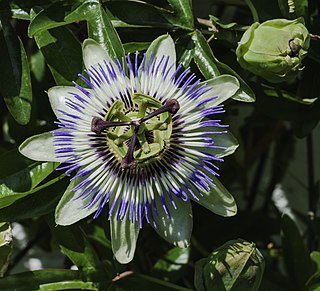
Passiflora caerulea, the blue passionflower, bluecrown passionflower or common passion flower, is a species of flowering plant native to South America. It has been introduced elsewhere. It is a vigorous, deciduous or semi-evergreen tendril vine growing to 10 m (33 ft) or more. Its leaves are palmate and fragrant, flowers blue-white with a prominent fringe of coronal filaments in bands of blue, white, and brown. The ovoid orange fruit, growing to 6 cm (2 in), is edible but bland.

Acer circinatum, the vine maple, is a species of maple native to western North America, from southwest British Columbia to northern California, usually within 300 kilometres (190 mi) of the Pacific Ocean coast, found along the Columbia Gorge and Coastal Forest. It belongs to the Palmatum group of maple trees native to East Asia with its closest relatives being the Acer japonicum and Acer pseudosieboldianum. It can be difficult to distinguish from these species in cultivation. It is the only member of the Palmatum group that resides outside of Asia.

Canna indica, commonly known as Indian shot, African arrowroot, edible canna, purple arrowroot, Sierra Leone arrowroot, is a plant species in the family Cannaceae. It is native to much of South America, Central America, the West Indies, and Mexico. It is also naturalized in the southeastern United States, and much of Europe, sub-Saharan Africa, Southeast Asia, and Oceania. Canna indica has been a minor food crop cultivated by indigenous peoples of the Americas for thousands of years.

Brachychiton rupestris, commonly known as the narrow-leaved bottle tree or Queensland bottle tree, is a tree in the family Malvaceae native to Queensland, Australia. Discovered and described by Sir Thomas Mitchell and John Lindley in 1848, it gained its name from its bulbous trunk, which can be up to 3.5 metres (11 ft) diameter at breast height (DBH). Reaching 10–25 metres (33–82 ft) high, the Queensland bottle tree is deciduous, losing its leaves between September and December. The leaves are simple or divided, with one or more narrow leaf blades up to 11 centimetres (4 in) long and 2 centimetres (0.8 in) wide. Cream-coloured flowers appear from September to November, and are followed by woody boat-shaped follicles that ripen from November to May. No subspecies are recognised.

Araujia sericifera is a perennial vining plant in the genus Araujia, of the family Apocynaceae. The species was described in 1817 by the Portuguese botanist Félix Avelar Brotero. The synonym Araujia hortorum is in more frequent use in New Zealand. Its common names include moth plant, white bladderflower, common moth vine, cruel vine and false choko.
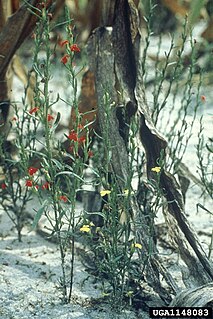
Striga asiatica, the Asiatic witchweed or the red witchweed, is a hemiparasitic plant in the family Orobanchaceae. It is native to Asia and sub-Saharan Africa, but has been introduced into other parts of the world including Australia and the United States. Asiatic witchweed is a serious agricultural pest, as it parasitises important crop species, including corn, rice, sorghum, and sugar cane, often causing substantial yield reductions.
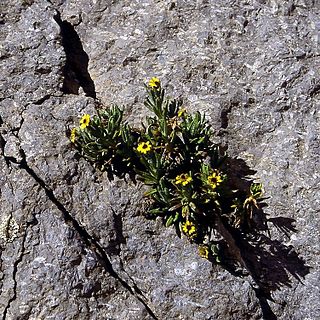
Atop of Mount Kenya Senecio keniophytum is one of the endemic groundsel (Senecio) found at high altitudes in Kenya, such as the Afro-alpine zone of Mount Kenya, but not one of the giant Dendrosenecio that also live there.
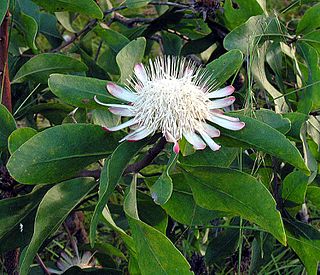
Protea gaguedi is a species of tree which belongs to the genus Protea.

Protea welwitschii is a species of shrub or small tree which belongs to the genus Protea, and which occurs in bushveld and different types of grassland.

Protea aristata is a compact shrub with beautiful flowers which is endemic to the southwestern part of the Cape Region of South Africa. P. aristata has become one of South Africa's most famous proteas in spite of its relatively late discovery, and re-discovery in 1953. The leaves are soft, dense and needle-like and the flower heads are a stunning crimson red, it may thus be a good potential ornamental plant for South African gardens. It is usually called the Ladismith sugarbush in South African English, although it has been called pine sugar bush in Australia. In the Afrikaans language it has the vernacular name of klein-den-suikerbos.

Senecio tamoides, also known as Canary creeper, is a climbing member of the genus Senecio of the family Asteraceae that is native to Southern Africa. It is used as an ornamental plant for its showy yellow, daisy-like flowers in autumn.

Smilax aspera, with common names common smilax, rough bindweed, sarsaparille, and Mediterranean smilax, is a species of flowering vine in the greenbriar family.

Nepenthes chang is a tropical pitcher plant endemic to the Banthad Mountains of central Thailand, where it grows at elevations of 300–600 m above sea level. It is thought to be most closely related to N. kampotiana.
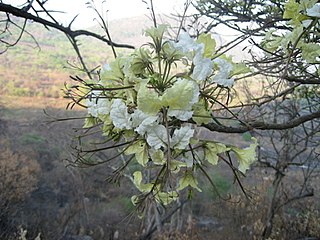
Cladostemon kirkii, commonly known as the three-finger bush, is a small deciduous tree belonging to the Capparaceae or caper family. It is a genus that has only this one species (monotypic). It is distributed through Kenya, Tanzania, Malawi, Mozambique, Zambia, Zimbabwe, Swaziland and KwaZulu-Natal in Southern Africa.
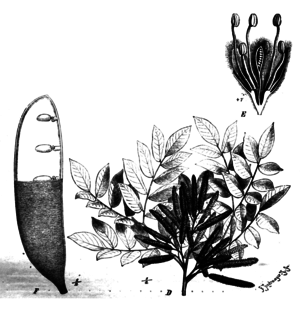
Erythrophleum suaveolens, also known as the ordeal tree, is a species of plant that can be found in Mozambique and Zimbabwe. The species are 20 metres (66 ft) in height, and have a rough and blackish bark. The plants leaves have 2–3 pairs of pinnae, which carry 7–13 leaflets. The leaflets are 5 by 2.5 centimetres, are green coloured and ovate. The flowers have fluffy spikes, and are creamy-yellow coloured. Fruits are hard, the pod of which is flat.

Grevillea parallela, also known as silver oak, beefwood or white grevillea, is a tree native to northern Australia.
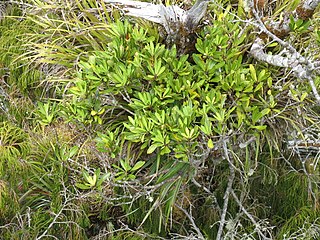
Pittosporum kirkii is a glabrous evergreen perennial shrub that reaches up to 5 metres (16 ft) in height and possesses distinctive coriaceous, fleshy, thick leaves. It is one of four shrubs endemic to New Zealand that frequently displays an epiphytic lifestyle. P. kirkii is commonly epiphytic, perched amongst nest epiphytes in the canopies of emergent or canopy trees in old-growth forest; however, it can be observed occasionally growing on the ground or over rocks. Kirk first observed P. kirkii on Great Barrier Island. It was described by Joseph Dalton Hooker from material collected by Thomas Kirk, possibly from the Thames Goldfields, and published in 1869. The initial brief description titled Pittosporum n. sp.? by Thomas Kirk was published in his paper on Great Barrier Island in 1868. This description along with herbarium specimens were sent to Dr. J. D Hooker at Kew Gardens in 1868, and he collaborated to name it after T. Kirk, by giving it the specific epithet kirkii within the publication that was otherwise written by Kirk.

Landolphia is a genus of flowering plants in the family Apocynaceae first described as a genus in 1806. They take the form of vines that scramble over host trees. Landolphia is native to tropical Africa.
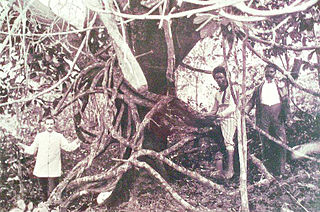
Landolphia owariensis is a species of liana from the family Apocynaceae found in tropical Africa. Latex can be extracted from this plant for the manufacture of natural rubber. Other names for this vine are eta, the white rubber vine and the Congo rubber plant. Congo rubber was a commercial rubber exported from the Congo Free State starting in 1890, most notable for its forced harvesting under conditions of great human suffering, in the Congo Free State, detailed in the 1904 Casement Report. From 1885 to 1908, millions died as a result of murder, deprivation, and disease, with population falling by millions in this period; some writers estimate this loss to be as high as 10 million people.
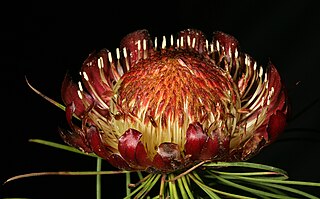
Protea pityphylla, also known as Ceres sugarbush or mountain rose, is a flowering shrub of the genus Protea, in the family Proteaceae. The plant is endemic to the southwestern Cape Region of South Africa.



















